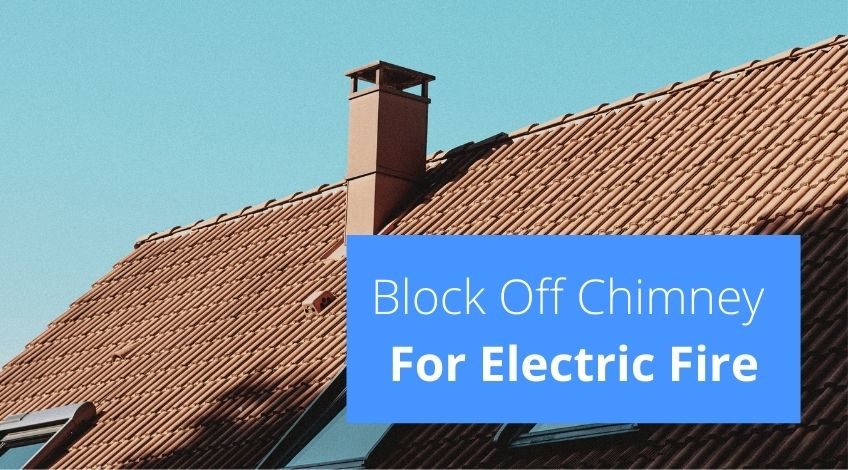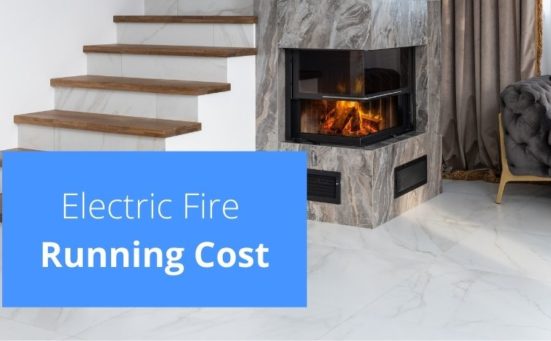
How To Block Off Chimney For Electric Fire
If you have a fireplace in your home, but don’t use it for a fire, you could be letting a high percentage of your hot air out of the home through the chimney opening. To block the chimney off is a simple task but it could save you a lot of money on your heating bill. Caution is needed though, because if you don’t do it correctly, you will cause problems with damp in your home.
If the chimney is open (and most are) every time it rains, some water will be entering the chimney and falling down the inside of your chimney making the brickwork damp. If the chimney has been used in the past for any type of open fire, there will be remnants of soot on the inside walls of the chimney. The moisture will seep into the walls mixing with the soot and making a black paste type liquid.
If you completely block the bottom of the chimney, that soot laden moisture will have nowhere to go except to seep through the interior walls of the chimney breast. This will result in a black, messy, damp patch appearing on your wallpaper or wall surface. To prevent this from happening you must install a vent so moist air can escape.
How Much Does It Cost To Remove A Fireplace?
If you are considering removing your old fireplace and replacing it with a modern electric fireplace, here’s a handy guide on the average costs of removing the old fireplace.

| Type Of Fireplace To Be Removed | Average Cost For Removal UK |
|---|---|
| Coal Fire Removal | £100 plus VAT |
| Wood Fire Removal | £100 plus VAT |
| Electric Fire Disconnection & Removal | £150 plus VAT |
| Gas Fire Disconnection & Removal | £150 plus VAT |
These are just average prices for a guide only. Get 2 or 3 quotes from different reputable tradesmen before making a decision. There are also regional variations in any pricing, always check before the work commences that you have been quoted the all inclusive price. To save any nasty surprises after the work is completed.
Why You Should Use Professional Experts
It’s always best to call in an expert to do any job in your home, remember it’s your biggest investment and your home. If anything goes wrong you won’t just be out of pocket, you could potentially be homeless. If you are having a gas fire removed it should be by a Gas Safe registered gas engineer. This will ensure your safety, the safety of your home and quality of the work done.
Likewise with any electrical work be sure the electrician is registered with either NICEIC or NAPIT these are the equivalent of the gas safe scheme for electricians. Builders should also be registered with NHBC or FMB this guarantees they are certified and competent to carry out any work you contract them to do. Roofers should be registered with either the NFRC or the CORC for the same reassurances with any roofing works.
What To Use To Safely Block The Bottom Of The Chimney
There are a number of ways to block the chimney safely, some are easier than others. Let’s have a look at them to see which method suits you best.
Chimney Balloon
This is an inflatable plastic bag that is inserted into the chimney just high enough to be out of sight, then inflated. The chimney balloon has a small hole to allow ventilation but not large enough to lose much heat. If you ever decide to reuse the fireplace for a real fire, simply deflate the balloon and the chimney is open again.
Just measure the inside of the chimney just above the eyeline. Be sure to measure all 4 sides. Then buy the appropriate size for your chimney. These can be purchased online for around £15
Chimney Sheep
This has been described as the chimney draught excluder, and that’s a pretty good description. As the name implies, it’s made from wool, and it simply pushes up into the chimney to block the hole. It prevents draughts and moisture but still allows the chimney to breathe.
Follow the measuring instructions for the chimney balloon and order the appropriate size for your chimney. These are available online for around £10 to £20 depending on the size.
Using Plywood To Block The Chimney
When we removed our old back boiler, we were left with a gaping hole that looked unsightly and let cold air into our home. We set about boxing it in so we could fit an electric log burner effect stove in the space left from the removal of the boiler. We secured some 2 x 1 around each of the 4 sides, just above the eyeline.
We then attached a piece of plywood to the underside of the 2 x1 and drilled 4 holes in the middle of the plywood. We screwed a vent over the holes to allow the chimney to breathe then placed the electric log burner in the hole.
On the outside we secured a piece of 4 x2 to the wall either side of the fireplace and screwed an 8 inch wide, 1 inch thick piece of wood along the length of the top. This was then undercoated, and painted white and now we have a wooden mantlepiece with a log burner inside.
How To Block The Chimney From Outside
We never tackled this, our chimney has a vent on it that prevents birds and to a certain extent rain getting through. But if you have an open chimney with no vent it is favourable to get this blocked properly. If you feel confident you can get up on the roof and have a go yourself or hire a professional.
To supply and fit a chimney cap will cost around £150 to £250 depending on the type of chimney you have and the area you live in. Be prepared for additional costs that might crop up like:
- Scaffold hire costs
Depending how high your property is and the builder/roofer/chimney sweep doing the work they might insist on scaffolding. Discuss this and any other hidden costs before entering into any agreement. - Repairs to chimney mortar or brickwork
If nobody has been on your roof for a while there is always the possibility that the mortar or even some bricks are missing or in need of repair/replacement. - Damaged chimney cap or crown
This is not always obvious from the ground, but could be a problem. Be sure to get a quote before any work is carried out.
In the old days chimneys were capped using lead capping, but they can cause condensation, so now roofers use the C-Cap. C-Caps prevent heat loss while still allowing ventilation.
Frequently Asked Questions
Electric fires need no vents at all, because they produce no gases, smoke or other harmful pollutants. However, if you are putting an electric fire in an old fireplace that you have blocked, that will probably need a vent to prevent damp.
You can put an electric fire in a fireplace as long as you have a socket nearby. It is not safe to run an electric fire on an extension cable.
Chimneys have cowlings or caps to prevent rainwater from coming down the chimney.
If you are not using the chimney, you can stop cold air coming down it by installing a chimney balloon or a chimney sheep.
A blocked chimney can cause damp due to condensation building up inside. If the top is capped and the bottom is blocked there is nowhere else for the moisture to go, than through the walls. The chimney needs to be vented to prevent this damp.
Chimneys do let cold air in when not in use. When there is a fire burning the chimney sucks hot air and smoke out and allows fresh air to enter. When not in use it sucks warm air from the room and replaces it with cold air.
It is normal for rain to drop down damaged or worn chimneys.
You can reduce air leaks by 14% and save around £200 per year by blocking the chimney according to the US Department of Energy.
Also, follow us on Pinterest ...



